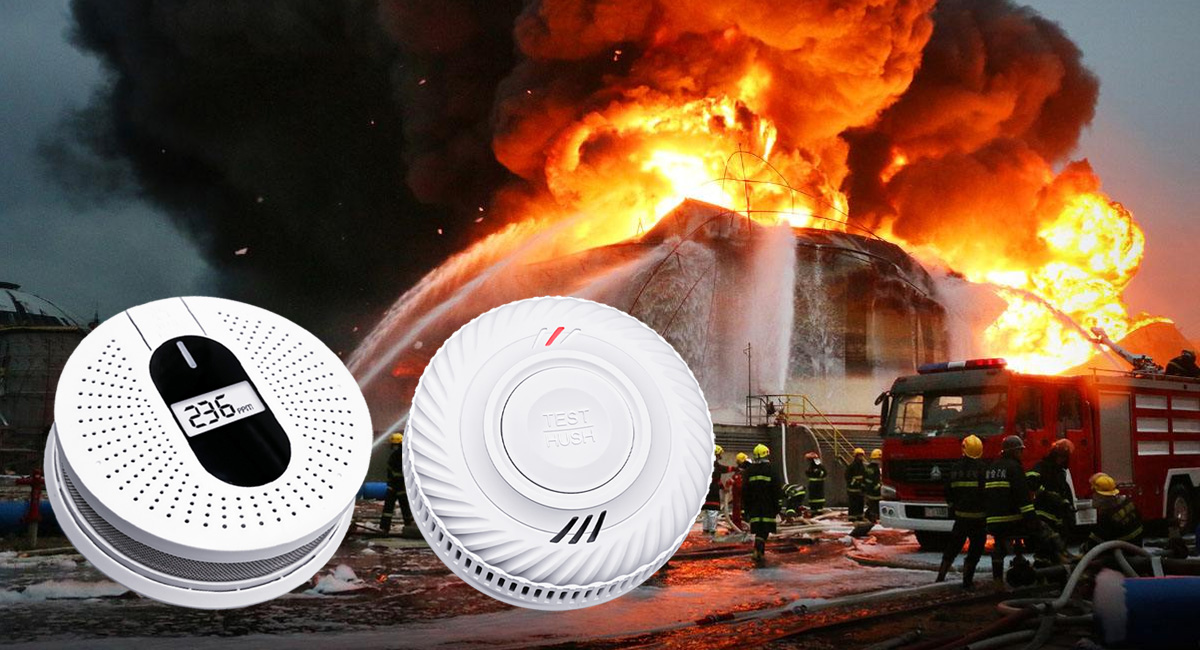According to the National Fire Protection Association, there are more than 354,000 residential fires each year, killing an average of about 2,600 people and injuring more than 11,000 people. Most fire-related deaths occur at night when people are asleep.
The important role of well-placed, quality smoke alarms is obvious. There are two main types of smoke alarms – ionization and photoelectric. Knowing the difference between the two can help you make the best decision about smoke alarms to protect your home or business.
Ionization smoke alarms and photoelectric alarms rely on completely different mechanisms to detect fires:
Ionization smoke alarms
Ionization smoke alarms are a very complex design. They consist of two electrically charged plates and a chamber made of a radioactive material that ionizes the air moving between the plates.
The electronic circuits within the board actively measure the ionization current generated by this design.
During a fire, combustion particles enter the ionization chamber and repeatedly collide and combine with ionized air molecules, causing the number of ionized air molecules to decrease continuously.
The electronic circuits within the board sense this change in the chamber and, when a predetermined threshold is exceeded, an alarm is triggered.
Photoelectric smoke alarms
Photoelectric smoke alarms are designed based on how smoke from a fire changes the intensity of light in the air:
Light scattering: Most photoelectric smoke detectors work on the principle of light scattering. They have an LED light beam and a photosensitive element. The light beam is directed to an area that the photosensitive element cannot detect. However, when smoke particles from the fire enter the path of the light beam, the beam hits the smoke particles and is deflected into the photosensitive element, triggering the alarm.
Light blocking: Other types of photoelectric alarms are designed around light blocking. These alarms also consist of a light source and a photosensitive element. However, in this case, the light beam is sent directly to the element. When smoke particles partially block the light beam, the output of the photosensitive device changes due to the reduction in light. This reduction in light is detected by the alarm's circuitry and triggers the alarm.
Combination alarms: In addition, there are a variety of combination alarms. Many combination smoke alarms incorporate ionization and photoelectric technology in hopes of increasing their effectiveness.
Other combinations add additional sensors, such as infrared, carbon monoxide, and heat sensors, to help accurately detect real fires and reduce false alarms due to things like toaster smoke, shower steam, and so on.
Key Differences Between Ionization and Photoelectric Smoke Alarms
Many studies have been conducted by Underwriters Laboratories (UL), the National Fire Protection Association (NFPA), and others to determine the key performance differences between these two main types of smoke detectors.
The results of these studies and tests generally reveal the following:
Photoelectric smoke alarms respond to smoldering fires much faster than ionization alarms (15 to 50 minutes faster). Smoldering fires move slower but produce the most smoke and are the most lethal factor in residential fires.
Ionization smoke alarms typically respond slightly faster (30-90 seconds) to fast-flame fires (fires where flames spread quickly) than photoelectric alarms. The NFPA recognizes that well-designed photoelectric alarms generally outperform ionization alarms in all fire situations, regardless of type and material.
Ionization alarms failed to provide adequate evacuation time more often than photoelectric alarms during smoldering fires.
Ionization alarms caused 97% of "nuisance alarms"—false alarms—and, as a result, were more likely to be disabled altogether than other types of smoke alarms. NFPA recognizes that photoelectric smoke alarms have a significant advantage over ionization alarms in false alarm sensitivity.
Which smoke alarm is best?
Most deaths from fires are not from flames but from smoke inhalation, which is why most fire-related deaths—nearly two-thirds—occur while people are asleep.
That being the case, it's clear that it's extremely important to have a smoke alarm that can quickly and accurately detect smoldering fires, which produce the most smoke. In this category, photoelectric smoke alarms clearly outperform ionization alarms.
In addition, the difference between ionization and photoelectric alarms in fast-flaming fires proved to be minor, and NFPA concluded that high-quality photoelectric alarms are still likely to outperform ionization alarms.
Finally, since nuisance alarms can cause people to disable smoke detectors, rendering them useless, photoelectric alarms also show an advantage in this area, being far less susceptible to false alarms and therefore less likely to be disabled.
Clearly, photoelectric smoke alarms are the most accurate, reliable, and therefore safest choice, a conclusion supported by the NFPA and a trend that can also be observed among manufacturers and fire safety organizations.
For combination alarms, no clear or significant advantage was observed. The NFPA concluded that the test results did not justify the requirement to install dual technology or photoionization smoke alarms, although neither is necessarily harmful.
However, the National Fire Protection Association concluded that photoelectric alarms with additional sensors, such as CO or heat sensors, do improve fire detection and reduce false alarms more.
Post time: Aug-02-2024












